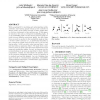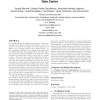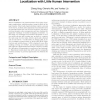MOBICOM
2012
ACM
12 years 3 months ago
2012
ACM
While a natural fit for modeling and understanding mobile networks, time-varying graphs remain poorly understood. Indeed, many of the usual concepts of static graphs have no obvi...
MOBICOM
2012
ACM
12 years 3 months ago
2012
ACM
The cellular industry is evaluating architectures to distribute the signal processing in radio access networks. One of the options is to process the signals of all base stations o...
MOBICOM
2012
ACM
12 years 3 months ago
2012
ACM
Indoor localization is of great importance for a range of pervasive applications, attracting many research efforts in the past decades. Most radio-based solutions require a proce...
MOBICOM
2012
ACM
12 years 3 months ago
2012
ACM
Given that full duplex (FD) and MIMO both employ multiple antenna resources, an important question that arises is how to make the choice between MIMO and FD? We show that optimal ...
MOBICOM
2012
ACM
12 years 3 months ago
2012
ACM
In this paper, we propose a novel clock calibration approach called FLIGHT, which leverages the fact that the fluorescent light intensity changes with a stable period that equals...
MOBICOM
2012
ACM
12 years 3 months ago
2012
ACM
MOBICOM
2012
ACM
12 years 3 months ago
2012
ACM
Current wireless network design is built on the ethos of avoiding interference. In this paper we question this long-held design principle. We show that with appropriate design, su...
MOBICOM
2012
ACM
12 years 3 months ago
2012
ACM
GPS is one of the most widely used wireless systems. A GPS receiver has to lock on the satellite signals to calculate its position. The process of locking on the satellites is qui...
MOBICOM
2012
ACM
12 years 3 months ago
2012
ACM
Rate adaptation (RA) has been used to achieve high goodput. In this work, we explore to use RA for energy efficiency in 802.11n NICs. We show that current MIMO RA algorithms are ...
MOBICOM
2012
ACM
12 years 3 months ago
2012
ACM
As we are surrounded by an ever-larger variety of post-PC devices, the traditional methods for identifying and authenticating users have become cumbersome and time-consuming. In t...



